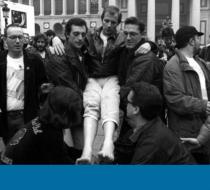AIDS 1 Favorite
Pepe Espaliú was an artist from Cordoba who made various art from paintings to sculptures and public actions. He was diagnosed with AIDS in 1990, and up until 1993 when he died, he focused on drawing attention to those affected by AIDS. The Reina Sofía had a small exhibition of some of his work in 1994, in which the work on display had a lot of symbolism about his condition and suffering. He had various sculptures of crutches and cages, not only referring to the pain him along with many other people with AIDs had suffered through, but also the isolation and marginalization they faced. The cages represented how ashamed they felt— back then, people with AIDS were shunned by society, disowned by family and friends, and many of them died alone or in secret. Espaliú expressed that “AIDS is that well where today I climb brick by brick, smudging my body by touching its black walls, drowning in its dense and humid air.” His newspaper publication, “Retrato del artists desahuciado”, expands upon the homophobia and exclusion Spanish society treated homosexuals and people with AIDs.
Espaliú was one of the first to outright inform the public that he had AIDS. His radical take on bringing awareness to AIDs is what made so many people recognize him as a pioneer of change. One of his most famous pieces conveyed the struggle against lack of communication regarding AIDS. Called “Carrying”, Espaliú repeated this performance in both Madrid and San Sebastian: he was transported by a human chain consisting of couples of friends and acquaintances, bare feet, sitting on their arms as they passed him from one couple to another, across kilometers. The wife of the President of the Government (Carmen Romero) was among those that helped carry him. Espaliú’s bare feet symbolized the exclusion and contempt society treated people with AIDS, and the fact that friends were physically touching him to carry him helped emphasize how the belief that one could contact AIDS just by casual contact was absolutely erroneous and so shrouded by ignorance and fear. It shocked the audience because it could have been considered reckless—everyone probably thought that he could have given AIDS to everyone who touched it. The next day, his performance flooded the news.
His objective to increase awareness about AIDS was successful because of how much attention his performance caught, but he achieved so much more by exposing a new way to view AIDS that much of society never did. He captured the suffering and the exclusion through his bravery rather than hiding in shame. He captured the noise, not just message, by involving emotion and passion through both “Carrying” and the piece he published in the newspaper. His art captured pain that pushed his audience to see people with AIDS as human. His art was made for not only the Spanish society, in my opinion, but for everyone as a human race to stop stereotyping and discriminating against people with AIDS.







